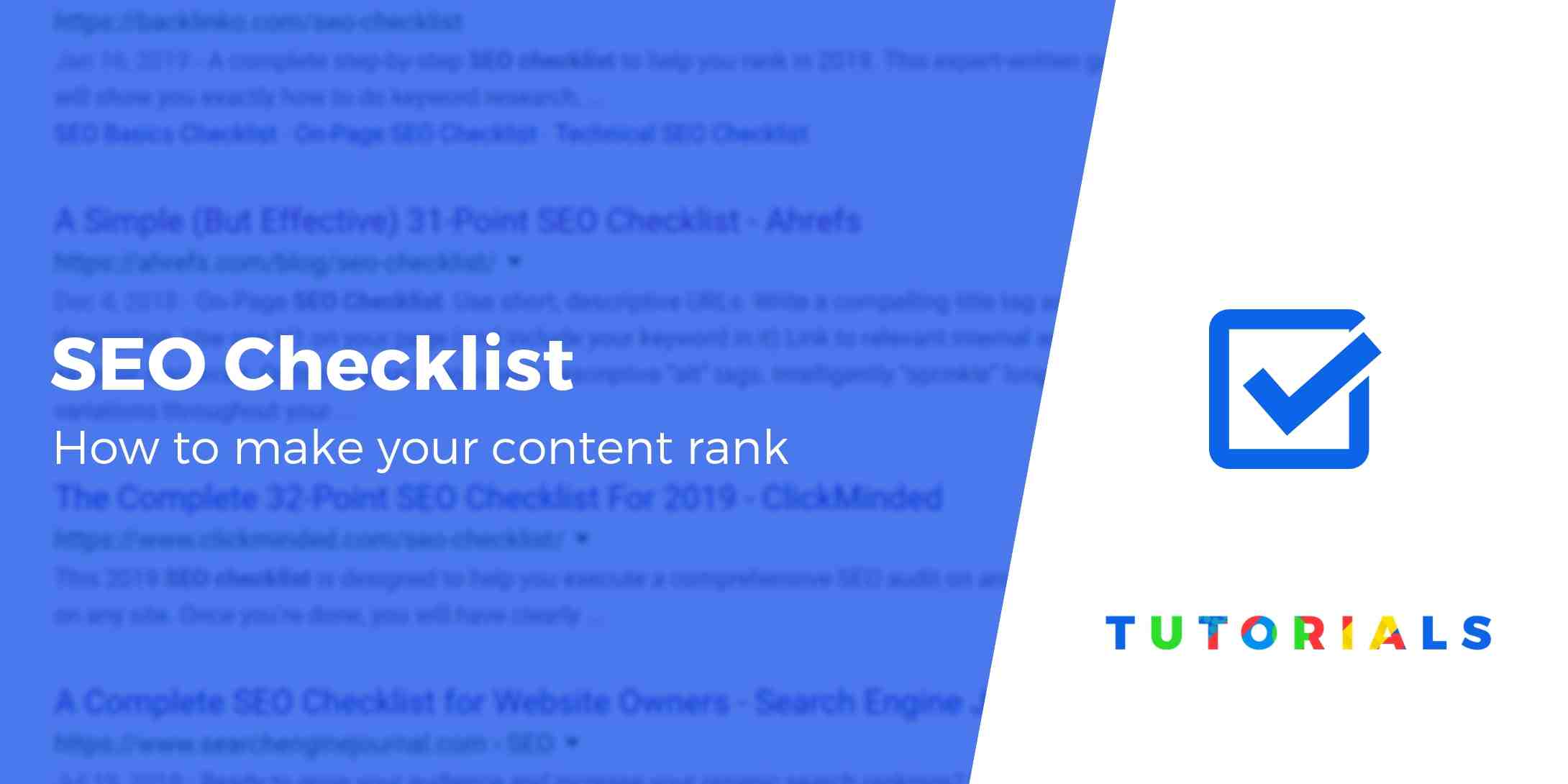Search engine optimization can be difficult. There are a few important things to consider if you want to improve your ranking. This checklist will help you create a strategy that will maximize the impact of your website on search engines. The following list of SEO tactics will give you an edge over your competitors. Includes technical and non-technical strategies. Here’s a look at each of them.
o Increase the number of relevant links to your site. Relevant links will increase your page ranking in Google. Many small business owners fail to understand this. It’s important to build links to your website and engage with the local community. The more you promote your small online business, the more likely it is that your site will be ranked on Google. You can also get links from local websites by asking for the links for you.
o Create a user experience for your website. You aim to improve the user experience so that your site is as user-friendly as possible. By taking the time to create the perfect user experience, small businesses can reach out to larger companies. An effective SEO checklist for small businesses will help you identify problems with your website. For example, make sure your content is well written and reads naturally. Avoid using keywords that are not relevant to your industry. Instead, include relevant keywords that your audience will find useful.
Make use of Open Site Explorer to analyze current backlinks to your website. Use this free tool to see what content is being referenced by other sites. If you have any dead links, please be sure to replace them with links to your website. Content repurposing is another effective SEO tip for small businesses. It will help you to diversify your content library. You should not expect immediate changes in your ranking.
Include a title for your images. This title will be displayed when a user’s cursor hovers over an image. The title should contain the main key. If you want the title to appear even if an image fails to load, add an alt-text attribute to the image tag in the HTML code. Be sure to compress the images to ensure they load faster. This also provides a better user experience.
Make use of H1 tags in your URLs. The H1 tag provides more evidence to Google when users search for a particular keyword. It’s also a good idea to use keywords in your anchor text. This way, Google can recognize and classify your website more effectively. Adding relevant and useful links to your content is another way to improve the ranking of your page. Finally, be sure to include a meta description for each page.
Create a content distribution strategy. When creating SEO strategies for small businesses, it’s important to think about how you can best use the content to reach your audience. Often, a simple blog post can make a big impact on your SEO. Creating a content strategy for your website can help you develop a clear understanding of your target audience and develop the best way to serve them.
Consistency. If your business name includes the word “company,” use consistent spelling and use the same handle across all social media platforms. Not only does it help SEO, but it also makes it easier to find online. Consistency is key. You want people to find your business through social media or search results. Creating an excellent content strategy will increase your chances of success for your business.
Focus on the most important factors for your website. The biggest mistake that small businesses make is to focus on the wrong keywords. Small businesses do not have the resources of large companies to create an amazing home page and get their link published on every major news source. Instead, they need to focus on high-value keywords and budget announcements. Ultimately, a focused strategy will lead to higher rankings and happier customers.
How do you rate your small business SEO performance, and what should you focus on next for greater success?
SEO is the process of optimizing your site to rank higher in search engines like Google, Bing, Yahoo, etc.
Your goal is to put yourself in front of researchers who can become your customers.
It’s important that your business also appears in different types of search results – Google Maps, organic, Featured Snippets, images and videos, and more – to maximize your visibility.
Small business SEO is the only challenge in that you probably don’t have a dedicated SEO team or a lot of time to stay informed on all the latest developments in search.
It competes not only against other small businesses, but also publishers, big brands, and all sorts of other sources of information that appear in search results.
And, of course, you don’t have the budget of those bigger rivals.
What does a small business do?
In this article, you’ll find an 11-point SEO checklist for small businesses that will help you prioritize and focus on those SEO tasks that will really move the needle for you, including:
Contents
- 1 1. Nail Down What Problems You Solve For Customers
- 2 2. Fix Your Technical SEO Issues
- 3 3. Optimize Your Pages
- 4 4. Optimize Your Google Business Profile
- 5 5. Find Out What Competitors Are Doing & Do It Better
- 6 6. Manage Local Business Listings & Citations
- 7 7. Get Links From Websites In Your Local Area
- 8 8. Add Schema Markup
- 9 9. Focus On Getting Reviews
- 10 10. Create Videos & Images For Competitive Keywords
- 11 11. Mix Paid With Organic To Get Going
- 12 Summary
1. Nail Down What Problems You Solve For Customers

Before you jump into SEO, you must first understand how people search. You can lose a lot of money in a paid search that targets the wrong people, or sends the wrong message to the right people.
Knowing who you are looking to reach and what problem you are solving for them is essential.
Start by asking questions such as:
These questions color the language that your customers use to find your business.
This information will guide your keyword research and content creation, among other activities.
(You can use these free keyword research tools to get started.)
2. Fix Your Technical SEO Issues

Your small business website may look good on the outside, with great graphics, colors and fonts.
But if there are technical issues “under the hood”, it will probably have an impact on your ranking and traffic.
Before embarking on a content or link campaign, spend time repairing the foundation.
You need a solid website structure so that search engines can rank well and index your web pages.
Some of the most common technical problems SEO has to do with:
Learn more about what it takes to do a technical SEO audit here.
3. Optimize Your Pages

On-page optimization is more than just putting a target keyword in strategic places on the page.
It’s important to develop well-structured, high-quality structured content written in natural language that incorporates your intended keywords.
Use every reasonable (i.e., non-spammy) opportunity to add your keywords appropriately to your website.
Otherwise, you are missing important rating signals. In other words, you have to optimize your:
4. Optimize Your Google Business Profile

Your GBP strategy should be a focal point for every small business. It’s free, easy to upgrade, and can make a big impact.
Screenshot from the search for [san diego candy shop], Google, January 2022
Ideally, your Google Business Profile provides all the information a potential customer needs to call, get directions, order online, or otherwise convert directly from the list.
The first step in optimizing your Google to-do list is to reclaim and verify it.
Make sure you fill in as many fields as you can and include photos and videos to reinforce your list.
Your choice of category is super important. Make sure you choose the correct categories for your business.
The primary category guides what attributes and other features are available to you.
If you want to get more advanced with your Google Business Profile, take the time to create questions and answers.
In local search results, there is a section on your list where people can ask questions and get answers.
As a small business, it is important to stay focused on these issues.
You can also create your own questions and provide answers to proactively provide information that could help researchers convert.
Read the new Google Business Profile: A Complete Guide to Learn More.
5. Find Out What Competitors Are Doing & Do It Better

Online competitors may differ from competitors in your local area.
For SEO purposes, we are the most concerned about the websites that appear in the top five to 10 positions of Google search results for your keywords.
These are the competitors you want to analyze.
When conducting a competitive analysis, use tools to know:
Also, we know that page speed is a factor in Google’s ranking algorithm.
Run your landing pages through page speed tools. Look for weak areas.
The Google Speed Insights page is a great place to start.
Screenshot from PageSpeed Insights, January 2022
For example, are their pages slow? Are there any missing keywords that you can target?
See 3 ways to quickly compare your website with your competitors for more useful tips.
6. Manage Local Business Listings & Citations
In addition to Google My Business, you need to monitor the accuracy of your local business data.
Data aggregators (e.g. Neustar Localeze, Factual) share information about local businesses, including name, address, and telephone number (NAP).
Make sure the NAP information for your business is consistent and accurate. Local business listings and quotes (i.e., online mentions of a business) can help improve your local presence.
It may be helpful to sign up for a service or use a local citation tool that will distribute your NAP information and monitor it for inaccuracies.
7. Get Links From Websites In Your Local Area
Most small business owners never think about links.
However, getting links to your site can help improve your ranking.
Which can mean more sales and more customers.
My “link attraction” approach has always been more than just an advertising angle.
What can we do to spread the word about our business, educate others, and participate in the community?
You will find lots of tips and tricks for local link building here.
8. Add Schema Markup
Schema markup helps search engines better understand the various components of a page, such as:
Using this branding can help you appear in rich rankings in the SERPs.
Screenshot from https://schema.org/LocalBusiness, January 2022
Find out all the different types of schemes available for local businesses here.
9. Focus On Getting Reviews
Even my kids are conditioned to look for reviews before making a purchase.
Local reviews were one of the top local search ranking factors in 2021, according to the Whitespark Local Ranking Factors report.
In addition, you can improve your conversions by making an effort to get reviews and feedback from your customers.
Platforms can help you organize and manage a review campaign.
Or, you can simply encourage customers to leave reviews on major online review sites.
These techniques can help you get more local reviews.
Be sure to answer that as well. Your answer (or lack thereof) is not only visible to the person who asked the question, but also to all other local researchers who see the journal in the future.
Even negative reviews are an opportunity to connect with the customer and show others that you care.
10. Create Videos & Images For Competitive Keywords
Websites need content, which means keywords, so that search engines understand what they are.
Content goes beyond words, however, and should include images and videos.
In fact, if you’re struggling to see competitive keywords, why not try a well-optimized video or image?
As Anna Crowe of SEJ recently wrote in her image optimization guide:
“Image optimization creates many benefits such as a better user experience, faster page load times, and additional ranking opportunities.
And it’s becoming more and more important. “
11. Mix Paid With Organic To Get Going
If you are new to SEO, it may take some time to get results.
SEO is a great game in the long run, but sometimes you just have to be more discriminating with the help you render toward other people. This is where paid search can really help.
While you’re building your SEO work, set aside a paid budget, so you can keep leads from coming in.
Even after you have a steady stream of organic traffic to your website, you can still consider running a paid search campaign in conjunction.
PPC ads can help increase your organic presence by placing placements where you have not been able to enter the top organic search results due to competition.
Read on and find 10 tips for successful local paid search here.
Summary
Even if the list of things to do seems confusing, the important thing is to start alone.
Start with the first goal you know you can accomplish.
Over time, you will discover local SEO tools that can make working faster and easier than the tactics that make a difference for you.
You will be able to build more inbound links from relevant and respectable local sources.
You can add new blog posts and other content to your website, helping to rank in a wider variety of search terms.
And, once you’ve worked with the introductory articles on this checklist, you’ll be ready to take your SEO strategy further.
I highly recommend Maddy Osman’s complete Local SEO Checklist when you’re ready for that next level.
Featured Image: Deemka Studio / Shutterstock
